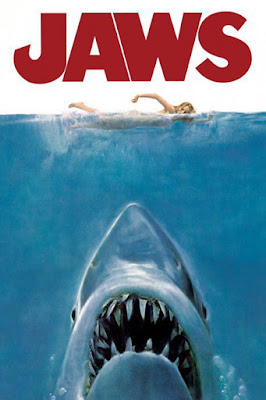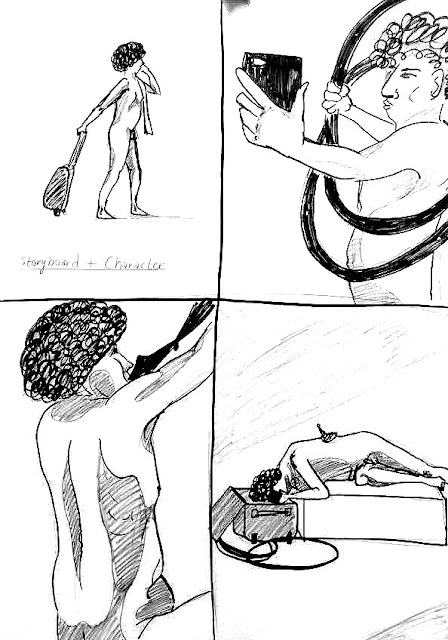 |
| Fig 1: Poster |
Steven Spielberg's Jaws (1975) is a mystery, suspense, thriller and horror movie. The film tells a story about a killer, giant shark that terrorises a small town. After the death of a girl, the Chief of Police, Martin Brody wants to shut down the beach, but the town mayor refused to close it down, because of the tourists money. However, after numerous death caused by the "rogue shark", finally the beach closes down for 24 hours and the case is left in Martins hand, who get on a boat with two other men; Matt Hooper (a shark expert), and Sam Quint (a local fisher man) in order to hunt down the great white shark.
Jaws was a huge success and set the Hollywood standards of blockbuster movies high. In fact the film was so positively received by people that 1975 was titled the year of the sharks, which meant that many other movies and media, such as music was inspired by not only sharks, but Jaws, and people's interest grew in buying posters, shirts, and other shark related items. As Douglas Gomery said "In 17 days, Jaws earned an extraordinary $36,000,000. House records were established in cities around the country, and record grosses continued through the summer. Indeed, Universal turned 1975 into the year of the shark." (Gomery, s.d.) The film was advertised on TV, which was avoided before, but it was another success and the overall income of the movie proved that if a film is marketed in the correct way, it could be an even bigger success.
It is very often highlighted by the team who worked on the film including Spielberg, that there were many difficulties while shooting the movie, such as shooting on open water instead of a studio pool and the constant failure of the shark machine. As said by Brian Eggert "The famous technical challenges of shooting on open water and mounting delays left plenty of time for actors to rethink the script on-set, and much on-camera improvisation resulted (including Scheider’s legendary line, “You’re gonna need a bigger boat.”)." (Eggert, B. (2012) In fact the shooting was so challenging in aspects of the shark, that they made three full sides pneumatically animated models, none of them actually working correctly at the end. Furthermore, the shooting had to start but as the filming started they did not have full cast, working shark props or even a fixed script and lots of dialog was improvised, including the famous and iconic line form the movie said by Martin: “You’re gonna need a bigger boat.”
It is very often highlighted by the team who worked on the film including Spielberg, that there were many difficulties while shooting the movie, such as shooting on open water instead of a studio pool and the constant failure of the shark machine. As said by Brian Eggert "The famous technical challenges of shooting on open water and mounting delays left plenty of time for actors to rethink the script on-set, and much on-camera improvisation resulted (including Scheider’s legendary line, “You’re gonna need a bigger boat.”)." (Eggert, B. (2012) In fact the shooting was so challenging in aspects of the shark, that they made three full sides pneumatically animated models, none of them actually working correctly at the end. Furthermore, the shooting had to start but as the filming started they did not have full cast, working shark props or even a fixed script and lots of dialog was improvised, including the famous and iconic line form the movie said by Martin: “You’re gonna need a bigger boat.”
 |
| Fig 3: Iconic line: "You’re gonna need a bigger boat." |
Due to the fact that most of the footage of the shark were unusable or not quite what the director wanted, creative editing had to be done in order to save the movie that previously was predicted (before the actual finished film and release of it) to be a huge fail and disaster. In an article Mark Kermode says "Unable to get the shark action shots he wanted, Spielberg was forced to take a more Hitchcockian approach, working with editor Verna Fields to conjure tense sequences in which what we don’t see is more important that what we do." (Kermode, 2015)
 |
| Fig 4: Bruce the shark behind the scenes. |
As it further discusses by many critiques and articles, the shark itself looked rather fake and not as threatening as it was required. The crew spend lots of time, which of almost all went to waste on making the machine shark work, getting correct shots and making the shark look fearsome. Huge chunks of the footage of the shark went to the cutting floor and now they had a movie on their hand that was a potential 'hit'. The director said that he originally wanted to make a monster movie, but seeing the progress of the shooting, the plan changed and it became a praised suspense movie. Bruce the shark (named after Spielberg's lawyer) only appeared fully and more often towards the end of the film, which left the audience more scared than if the shark was shown right from the beginning (even though we already know it is a shark from right the beginning)."The threat of what you can’t see is far more worrying than the fear of what you can - especially if it is likely to rise up out of the water and bite you between the legs, having first removed them. It’s the opposite of a voyeur’s movie since Bruce, for all the special effects men’s skill, is less scary the moment he’s visible." (Malcolm, 2016)
 |
| Fig 5: Barely visible shark pulling victim under the water. |
Lastly, the question that always arises while discussing Jaws: What it is about? There has been lots of suggestions of the real meaning of the film. Some of the most popular theories include, it is about Watergate, masculinity, feminism, atom bomb, the shark being a sexual predator and serial killer, and many others ideas have surfaced, but despite some of these theories would make sense and their reasoning is fair the director keeps claiming that this is simply a shark movie and nothing else. "So, Jaws isn’t a film about infidelity? (Or masculinity? Or Watergate? Or whatever?) “No,” replied Spielberg definitively. “It’s a film about a shark.” (Kermode, 2015)
 |
| Fig 6: End scene, death of the shark. |
Bibliography:
- Dowell, B. (2015) Is Jaws just a film about a shark... or something else? At: http://www.radiotimes.com/news/2015-06-21/is-jaws-just-a-film-about-a-shark-or-something-else (Accessed on 14.02.17)
- Eggert, B. (2012) Jaws. At: http://deepfocusreview.com/definitives/jaws/ (Accessed on 14.02.17)
- Gomery, D. (s.d.) JAWS - Film (Movie) Plot and Review. At: http://www.filmreference.com/Films-Im-Le/Jaws.html (Accessed on 14.02.17)
- Kermode, M. (2015) Jaws, 40 years on: ‘One of the truly great and lasting classics of American cinema’. At: https://www.theguardian.com/film/2015/may/31/jaws-40-years-on-truly-great-lasting-classics-of-america-cinema (Accessed on 14.02.17)
- Malcolm, D. (2016) Steven Spielberg's Jaws review - archive, 1975. At: https://www.theguardian.com/film/2016/dec/22/jaws-steven-spielberg-1975-review-derek-malcolm (Accessed on 14.02.17)
Illustration List:
- Figure 1: Poster (2014) [Poster] At: http://www.slashfilm.com/original-jaws-poster-art-missing/ (Accessed on 14.02.17)
- Figure 2: The shark emerging from the water, attacking the boat. (s.d.) [Gif/Online] At: https://giphy.com/gifs/ocean-attack-12Jbd9dZVochsQ (Accessed on 14.02.17)
- Figure 3: Iconic line: "You’re gonna need a bigger boat." (2016) [Gif/Online] At: http://www.pref.com/a/clpd/21-awesome-behind-the-scenes-facts-you-probably-didnt-know-about-jaws (Accessed on 14.02.17)
- Figure 4: Bruce the shark behind the scenes. (2015) [Online] At: https://twitter.com/makingofs/status/592871395379585024 (Accessed on 14.02.17)
- Figure 5: Barely visible shark pulling victim under the water. (s.d.) [Gif/Online] At: https://nypdecider.files.wordpress.com/2015/05/jaws-gif-3.gif?w=618&h=261&crop=1 (Accessed on 14.02.17)
- Figure 6: End scene, death of the shark. (s.d.) [Gif/Online] At: http://www.slate.com/content/dam/slate/blogs/browbeat/2011/09/29/hugo_chavez_caption_contest/JAWS_Sharksplosion.gif.CROP.original-original.gif (Accessed on 14.02.17)













































